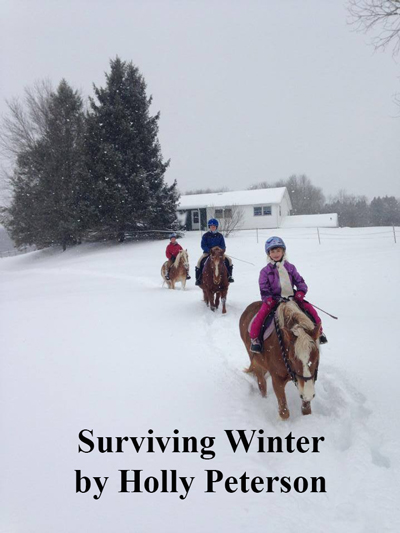Surviving Winter
by Holly Peterson
Upstate New York can bring interesting challenges for both horse and owner, especially for those of us without an indoor. The warm-cold-warm weather changes, icy footing and bitter winds can be enough to send even the craziest of horse lovers for cover. For many it’s a nightmare of amped up horses, frozen water tubs and stall cleaning that would make a saint curse. Surviving winter with all our body parts and a horse that isn’t completely crazed can be a little daunting but we’ll get there.
Turnout
I’ve entered into many a debate over winter turnout. It’s too cold for the horses, they might get hurt, and they don’t like it. Frankly, the only horses I’ve ever met that didn’t like turnout were ones that were conditioned that way. The ones, that as soon as a drop of rain or snow falls from the sky, they are rushed under cover.
They might get hurt. Yes, that’s true, but isn’t that true for anytime they go outside? I met a woman recently whose horse hadn’t been out in two weeks due to snow. Snow! I can tell you, this is not going to keep your horse “safe” it’s going to make them nuts and increase the possibility of them hurting themselves when you do finally let them out. My response to her was, “Go lock yourself in the bathroom and have someone throw food in the door as 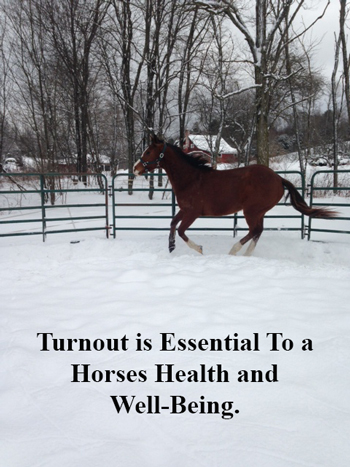 often as you feed your horse. How quickly will you start to get antsy to get out?”
often as you feed your horse. How quickly will you start to get antsy to get out?”
If you are truly worried about your horse injuring themselves on winter turnout, get them a pair boots. There are many different kinds of turnout boot to help protect their legs: Including sports boots, brush boots or galloping boot.
We turn out all winter long. Even on the bitterest, nastiest of days, my horses are outside, even if it’s only long enough to clean their stalls. Horses are social animals and they weren’t designed to stand in a stall all day long for days on end. It tends to make them a little stir crazy. If they seem like they are bored, try adding a jolly ball or plastic barrel for them to play with.
Not only is turnout good for them mentally, it’s better for their over all health. It gets the blood flowing and keeps their digestive track moving in the right direction. So unless the footing is dangerous, get them out, even if it’s only for an hour. They will tell you when they are too cold, want to come in or are just plain miserable..
Water
We all know it’s important to be sure you have fresh water available to them at all times. Impaction colic can be especially prevalent in the winter if they aren’t drinking enough. You can’t force them to drink but you can be certain to have plenty of ice-free water for them.
I got stuck in the vicious cycle of breaking ice on buckets, schlepping hot water from the house to the barn several times a day just to be sure these ungrateful beasts; that don’t even bother to drink the warm water, just to watch it freeze again, wouldn’t get sick. I did the heated stall bucket in the stall thing. However, I stopped using them because I found a few issues with using them. First, I realized that the heaters don’t register that there’s no water in the bucket and will continue to heat, causing them to crack or short-out when you add cold water to the empty hot bucket. You won’t always see it until 1- the bucket is draining on the floor, or 2- your horse won’t drink because he’s getting zapped by the bucket. Yes, both one and two happened to me. Next, a naughty pony showed me how flexible his little neck was and was able to get his teeth on the cord and chew on it, despite securing it on the outside of the stall. Thankfully he pulled hard enough to unplug it before he could hurt himself. Third, they don’t hold up to the horses rubbing on them.
If you chose to use the heated stall bucket a few things to keep in mind:
1. Make sure the bucket is secured to the wall so that it can’t swing around and expose the cord.
2. That the cord is secured away from anyplace the horse may be able to reach.
3. Check them regularly for shorts and cracks.
4. Make sure they are full at all times to avoid over heating.
We have installed tank heaters in all our outdoor water tanks. They have become our horses’ main source of water during the winter. The horses get a big drink going out in the morning, have access as long as they are out and get another big drink on the way in at night. We only add ½ a bucket of water at a time to their stalls while they are in or for the overnight to avoid the full frozen bucket the next morning.
We chose to install the bottom heater vs. the floaters. We have several horses that enjoy playing with things they shouldn’t and have ripped the floaters out of the tanks and used them for toys. We also found they didn’t keep the whole tank ice-free. We found the bottom heaters keep the whole tank ice free and frankly, warm, thereby encouraging the horses to drink more.
Did you know you don’t need to chip ice out of frozen buckets? Set them in the stock tank for 5 minutes and they melt enough of the ice to be able to get the ice out of the bucket, without having to whack at it with a hammer to break it out. Works for frozen hoses too, just make sure the hose isn’t touching the heating element.
Whether you use floaters of bottom heaters, water levels should be checked daily and kept full to avoid the horses messing with the heating element. Just because its winter doesn’t mean they don’t need to get cleaned either. We scrub the water tanks in the winter no less than 2x a month, more if we see algae starting to build up or if the water is gross.
Hay
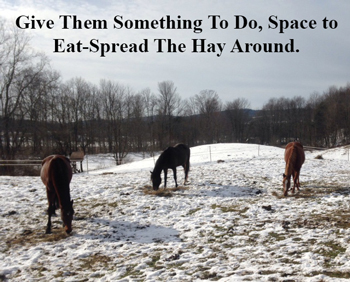 Feed lots of it! Hay is the primary source of nutrition in my program; we feed good quality hay first and then supplement their needs with grain. Horses are often referred to as ‘hay burners’ and it’s true. Horses bodies burn the hay to help the stay warm. Limiting their hay in the cold limits their ability to warm themselves.
Feed lots of it! Hay is the primary source of nutrition in my program; we feed good quality hay first and then supplement their needs with grain. Horses are often referred to as ‘hay burners’ and it’s true. Horses bodies burn the hay to help the stay warm. Limiting their hay in the cold limits their ability to warm themselves.
I know many feed round bales, however I am not an advocate of them for many reasons, but as it pertains to this, I don’t feel round bales encourage natural feeding patterns. All they do is stand and eat and eat and eat. This causes boredom and promotes food aggression. Unless you have 3 or less per round bale, someone in the herd will be getting chased off the food.
Horses are naturally grazers; they need that pattern of moving from spot to spot to eat, for the same reasons as mentioned earlier. To encourage this we use square bales and spread the hay all over the fields with lots of space in between flakes-putting out approximately ½ a bale per horse. Horses are encouraged to eat naturally and no one is left out as they can move from pile to pile to eat. If and when possible doing multiple small feedings over the course of the day vs. putting everything out at once will maximize your hay usage and help keep your horse busy throughout the day.
Our rule of thumb for feeding hay is 1 bale per horse per day; more or less depending on size, weight, and need. If they are leaving hay on the ground at the end of the day, cut back on how much you are putting out. If they are eating every last scrap and looking for more, may want to increase it a little bit.
Feed
I’m not an advocate of bumping grains up in the winter especially if all they are doing is standing around in a stall. Overloading your horse with grain when they don’t needing it can/will lead to obesity, hyper activity, laminitis, founder and/or colic. Unless the horse is losing weight, has special needs or is old and has trouble eating hay, grain amounts should stay about the same as the rest of the year, if not a little less. A little extra hay can go a long way.
Blanketing
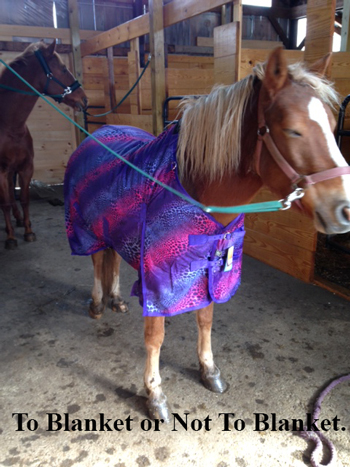 We’ve all seen or participated in the ‘Great Blanket Debate’ (check it out in more detail in this issue's Bit Between the Teeth article). Frankly, blanketing is one of those things that I do on a horse to horse basis. For example, last year one of my boarders said their horse was a hard keeper; the mare had no blanket and did indeed lose weight. Shortly after suggesting blanketing her, she started putting the weight back on. She wasn’t a hard keeper, she was just cold. Another came with an insanely think, heavy blanket. It was so thick and squishy; I wanted to wrap up in that thing some days. He had a super thick coat and was of a healthy weight. There was no reason for him to have anything anywhere near that thick. My ponies are fat and really woolly, they get a rain sheet for wet days, otherwise they are naked most of the winter.
We’ve all seen or participated in the ‘Great Blanket Debate’ (check it out in more detail in this issue's Bit Between the Teeth article). Frankly, blanketing is one of those things that I do on a horse to horse basis. For example, last year one of my boarders said their horse was a hard keeper; the mare had no blanket and did indeed lose weight. Shortly after suggesting blanketing her, she started putting the weight back on. She wasn’t a hard keeper, she was just cold. Another came with an insanely think, heavy blanket. It was so thick and squishy; I wanted to wrap up in that thing some days. He had a super thick coat and was of a healthy weight. There was no reason for him to have anything anywhere near that thick. My ponies are fat and really woolly, they get a rain sheet for wet days, otherwise they are naked most of the winter.
My rule of thumb: Are they cold? Are they clipped? Are they skinny? Are they losing 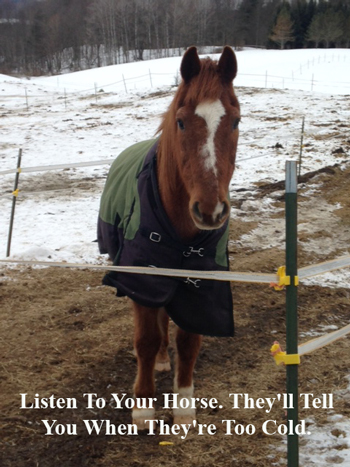 weight? Yes- blanket. No- no blanket.
weight? Yes- blanket. No- no blanket.
Is it raining/wet snow? Sub-zero? Below freezing wind-chill?
Yes- blanket. No- no blanket.
Each horse is different just like people. You see some people bundled up to the gills in 40 degree weather and they are still cold while others treat 40’s like its t-shirt and flip-flop weather. Listen to your horse, they will tell you what they need. Are they shivering? You are not always going to see your horse shivering, but they shiver for the same reasons we do, to generate heat. Are they losing weight? Assuming you are in fact feeding them enough, horses that rapidly lose weight are most likely shivering and using up the calories you are feeding them to try and get warm. Other signs that the horse is cold would include, tailed tucked between their legs, refusal to leave a sheltered area, buddying up to another horse, scrunching up their backs and rumps, a sour attitude or camping (butt to the wind) and refusing to move. Horses’ ears and a puffed up coat aren’t always a good indicator of how cold they are and should not solely be used to decide if your horse is cold.
I personally don’t clip any of my horse, but if your horse is clipped, from trace to full body, they need a blanket. They aren’t able to regulate there body temperature as well as a horse with a full coat. Just use a little common sense i.e. just because you are cold doesn’t mean they are.
Stall Care
Let’s be honest, there’s not a whole lot we can do about frozen manure. It freezes, it doesn’t pack down well- requires extra trips to the muck pit and if your lucky you wont break your ankle tripping over a pile of it. …There’s just nothing fun about cleaning stalls in the cold. The only thing I really recommend is giving them a nice thick layer of bedding to help insulate them from the cold seeping up from the floor.
Bare Foot vs. Shoes
Whether they are barefoot year round, have their shoes pulled just for the winter, or wear shoes year round, horses hooves should be on a regular trimming schedule of every 6-8 weeks, whether they are working or just being a winter pasture potato. Just because a horse isn’t in work doesn’t mean they don’t still need hoof care to smooth out the rough edges caused by frozen uneven ground.
Barefoot: If your horse isn’t in steady work and doesn’t “need” shoes for medically necessary reasons, there is no reason you can’t pull shoes for the winter. They are usually ouchy for a few days, and then are good to go. They are still able to be ridden and you have fewer issues with snowballs in their feet at turnout time.
Shoes: Horses that remain in steady work throughout the winter or need shoes for what ever reason, should at the very least, get some form of snow shoe or snow pad put on. Regular shoes don’t have a lot of traction (i.e. none) in the snowy conditions. Aluminum and Rimm shoes can give them slightly more traction. Borium can also be added to the toe or heel of the regular shoe to give them traction.
Whatever type of shoe you chose, they should also be fit with snow pads to minimize the build-up of snow in the shoe. Snow will pack into the shoe to the point of being high heels for the horse, causing stress to their fetlocks and knees as they try to walk. Not to mention it’s a pain to dig out.
This is another instance where it all depends on what the horse needs. I have a few that are barefoot year round and are sound happy and ridden year round. A few need summer shoes but have them pulled for winter and are still being ridden. Last are my horses that need shoes. I pull the backs and put snow pads in the front they are good to go.
Exercise
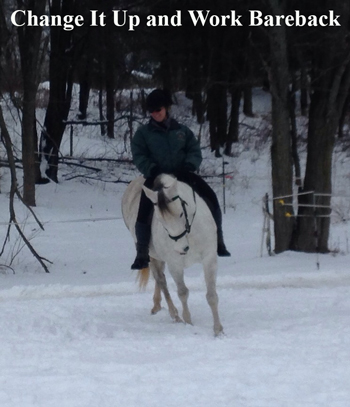 Horses need exercise. Whether you have an indoor arena or are a winter warrior braving the elements outside, cold is cold and it’s important to pay attention to the weather and ride smart. When winter riding, sessions should be kept appropriate to your horses level of fitness, the soundness of the footing and what you are trying to accomplish. If you haven’t ridden them in a month, taking them for a long hard gallop through the snow might not be the best idea. Rides like this can cause injury.
Horses need exercise. Whether you have an indoor arena or are a winter warrior braving the elements outside, cold is cold and it’s important to pay attention to the weather and ride smart. When winter riding, sessions should be kept appropriate to your horses level of fitness, the soundness of the footing and what you are trying to accomplish. If you haven’t ridden them in a month, taking them for a long hard gallop through the snow might not be the best idea. Rides like this can cause injury.
Even for the working or competition horse, who are used to working in the cold and snow, those winter warm-ups are important. They should be long and slow to allow plenty of time for those cold muscles to loosen up to avoid injury. Many chose to use coolers and ¼ sheets during warm-up, just be sure to take them off after warm-up to avoid over-heating your horse or getting them too sweaty.
Cool downs are just as important. Putting your horse up while they are still hot and sweaty can lead to injury, tight sore muscles or even illness. Take a few extra minutes to be sure they are completely cool and all the sweat has been dried.
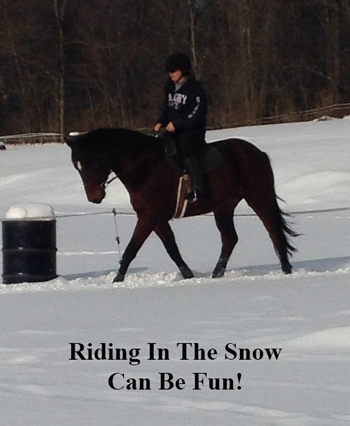 Riding in the snow can be a ton of fun! It doesn’t always have to be a serious work out. Take a bareback ride and get connected with your horse. Just remember, if you fall your landing in something soft. Check your footing before you ride. Be sure you know just what’s underneath the snow before you take off into that open field for a gallop. If you’ve had a lot of melt-freeze type weather, chances are you have some ice under there. Stick to areas you know are safe or keep it at a respectable pace.
Riding in the snow can be a ton of fun! It doesn’t always have to be a serious work out. Take a bareback ride and get connected with your horse. Just remember, if you fall your landing in something soft. Check your footing before you ride. Be sure you know just what’s underneath the snow before you take off into that open field for a gallop. If you’ve had a lot of melt-freeze type weather, chances are you have some ice under there. Stick to areas you know are safe or keep it at a respectable pace.
Too cold to ride? Yes we do hit a point where it can be too cold to ride. When you walk outside and take a breath and your lungs burn from the cold it means it is probably too cold to ride. When we hit that point when even the grass feels like concrete, it might be time to easy up on the workouts. That repeated concussion on the hard ground can damage their legs.
If you are in serious competition you are most likely at an indoor facility already, but that doesn’t mean there aren’t days that can be too cold. Unless you are lucky enough to have a heated indoor, riding in an indoor can be just as bitter, cold and miserable as riding outside, minus the wind. The cold doesn’t last forever. It’s O.K. to give them a day off here and there. There’s nothing saying you can’t still work your horse in the cold, just do something different. Work inside. Ground manners can always be improved. Set up a little obstacle course in the barn isle. Work with the “scary” stuff like tarps and bags. Teach them something new or just spend a little extra time grooming them.
Riders and Workers
Layers people, layers. That is how we crazy horse people survive working and riding in the winter. O.K., so maybe layers and ‘hot hands’ hand and foot warmers for the coldest of days. You gear up like the little kid from A Christmas Story before you head out, strip as you get working and the layer back up when you slow down. You don’t ever want to stay layered up and get sweaty, that’s how you get chilled and ultimately sick.
Winter riders need to invest in some great winter wear. Your not going to ride your best if you’re too busy shivering. Polar fleece or fleece lined britches are a great place to start. Seriously they are just warm. Insulated riding boots are also a must. Regular paddock boots just don’t hold the heat and don’t accommodate heavy winter socks very well. Layered but well fitting tops and jackets are also a must. You’re going to need to be able to take a layer off while you ride, so layers are a must. Too bulky or baggy and you can get hung up on your equipment. Winter riding gloves are definite must for retaining feeling in your hands. Lastly, a fleece helmet cover to keep your ears warm, especially for outdoor riding. Having cold ears is bad enough but having that winter wind whipping across your ears can be brutal.
For our intrepid barn workers, every good barn worker knows that you need six things to be happy working in the cold. Good insulated boots, cover-alls, gloves (sturdy, water proof and insulated) a hat and most importantly a heated tack room with a coffee maker. Even on the bitterest of days, I’m stripping out of my coat, then gloves then hat by at least the third stall.
Winter here can be a little brutal, but it doesn’t have to be brutal on us. Dress warm and ride on my fellow crazy horse people!



